I was introduced to the Uppinakayi range of pickles by Aparna Sitaraman and this summer I tried my hand at making this delectable Mavinakayi Uppinakayi, the no-oil water-based Mango Pickle from Karnataka.
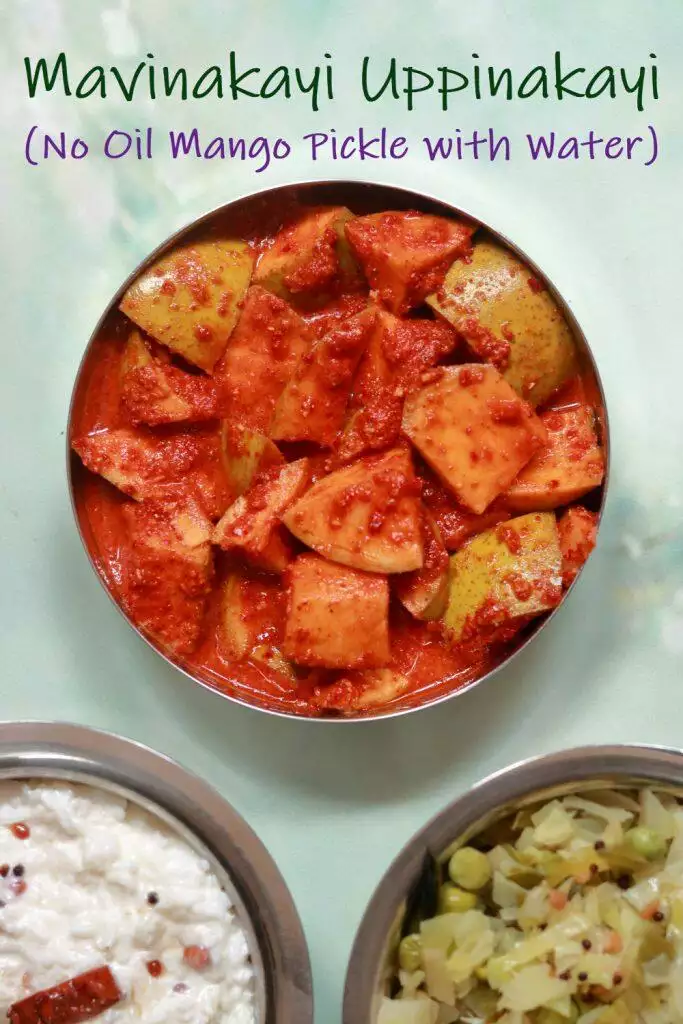
I make so many varieties of mango pickles every year that I now resort to making very small batches of each variety. Why you ask? Because I am find them simply irresistible and cannot bring myself to give up on any; a situation made worse every year by the new pickles I try.
While this year, I am on a go-slow with new types of mango pickles, I still could not resist making this delicious Mavinakayi Uppinakayi. The idea of enjoying a mango pickle that uses no oil was quite the attraction in trying this recipe.
Some Tips to Make Mavinakayi Uppinakayi
- As with all pickles, make sure everything that is used in making the pickle is bone dry; be it the container, utensil, grinder, spoon and even your person. While this is a water-based pickle, wet equipment will mean the pickle will spoil instantly.
- Use a mango that is dark green and firm. These will be sour and make for a good pickle.
- Use a glass bottle or a ceramic jar to store this pickle. Metal containers are avoidable because of the highly acidic nature of the pickle.
- After salting the mango pieces, use a dry spoon to mix the pieces every day. This is necessary because the water from the mangoes will ooze out and settle at the bottom. There is a slight danger of the mango pieces of top spoiling quickly.
- While it normally takes 3 to 4 days for all the water to seep out of the mango pieces, do check on the salted pieces every day. When the mango pieces soften and become light in colour, and there is quite a bit of liquid that has seeped out, make the Mavinakayi Uppinakayi. Every type of mango is different and pickling is an art as much as it is a science. If you leave the pieces to salt too long the pickle will spoil. 🙂
- While I have used whole chillies, chilli powder works just as well.
- While the pickle has a relatively long shelf life of a few months, refrigerate it to preserve it for a year or more.
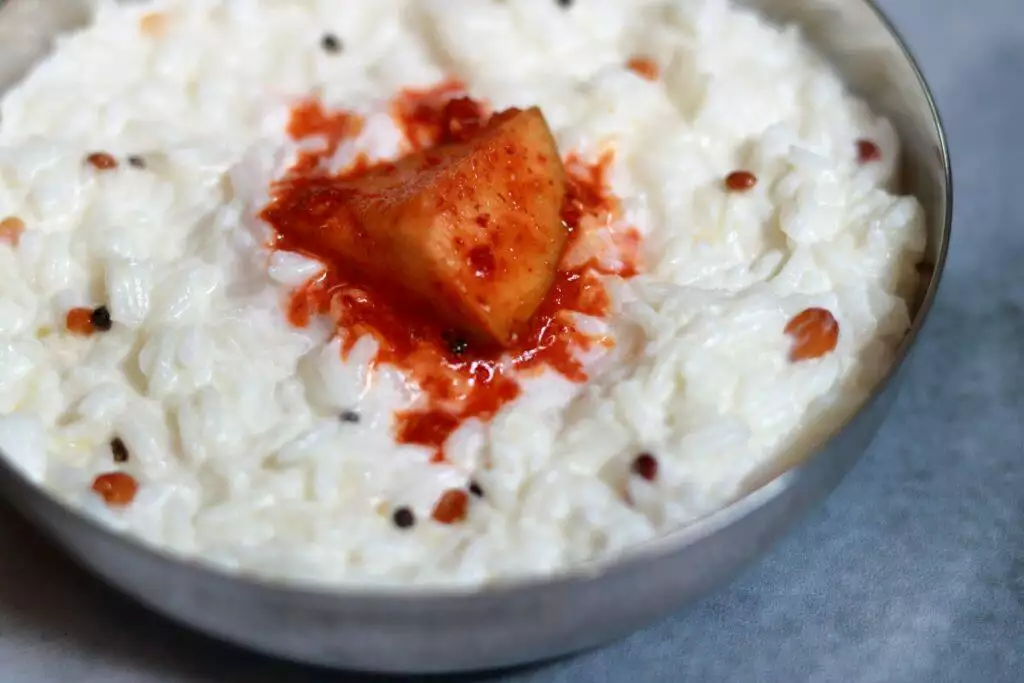
Recipes for Instant Mango Pickles
Here are some tried and tested recipes for instant mango pickles from across India:
- Ava Baddalu | Instant Andhra Mango Mustard Pickle
- Mamidikaya Menthi Baddalu | Menthi Mukkalu
- Neemki | Instant Mango Pickle From Himachal Pradesh
- Aam ka Hing Wala Achar | Instant, No Oil Mango Pickle with Asafoetida
How to Make Mavinakayi Uppinakayi
- Getting Ready
- Ensure you have a dry air-tight glass or ceramic jar of at least 400 ml capacity on hand.
- Ensure that the mango is dry. If required wipe with a dry cotton cloth and then air-dry it for 15 to 20 minutes.
- Salting the Mango Pieces
- Cut a large unripe mango (mine was about 300 gms) into 1″ pieces. After discarding the seeds, my pieces weighed 250 gms. This was 1.25 cups of pieces.

- Divide the mango pieces into 3 portions.
- Add one portion to the jar and add 1 tsp of salt on top of it.
- Now add another portion of mango pieces and add 1 tsp of salt.
- Finally add the third portion of mango pieces and 1 tsp of salt.
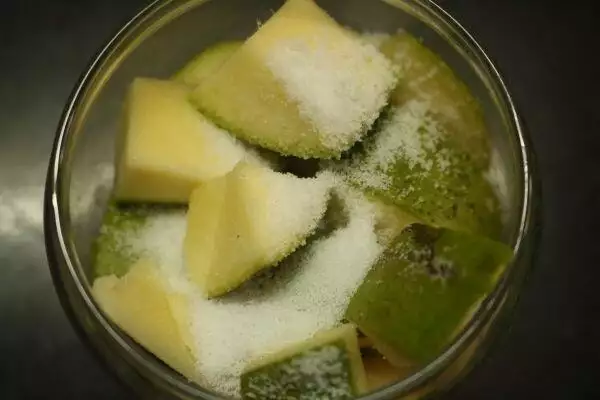
- Close the jar and shake a few times using a gentle motion so that the mango pieces and salt mix well.
- Set aside in a cool dark place for 3 days.
- Gently shake the bottle every day so that the mango pieces get covered in the juice that seeps out of the mango pieces.
- After 2 or 3 days, there will be a lot of juice that has settled at the bottom of the jar.

- Cut a large unripe mango (mine was about 300 gms) into 1″ pieces. After discarding the seeds, my pieces weighed 250 gms. This was 1.25 cups of pieces.
- Prepping the Spice Mix
- Dry roast 1 tsp of mustard seeds for a few seconds; just enough the warm them.
- Transfer to a plate to cool.
- Dry roast 8 dried red chillies for a few seconds; once again, just to warm them.
- Transfer to the plate to cool completely to room temperature.
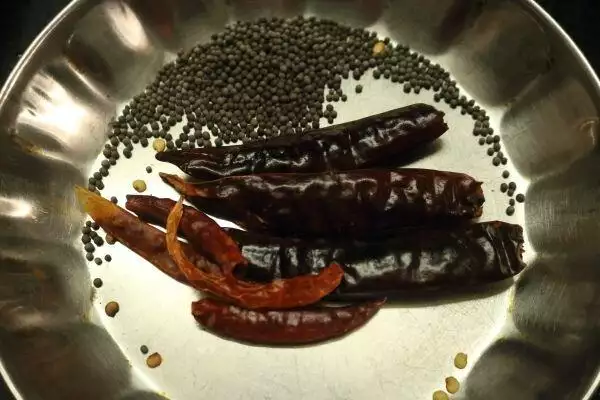
- Making the Mavinakayi Uppinakayi
- Ensure you have a large, dry soup strainer and a dry stainless steel vessel on hand.
- On day 3 after salting the mango pieces, using a dry soup strainer or colander, drain the juice from the mango pieces into a steel vessel. I got 1/4 cup of juice.
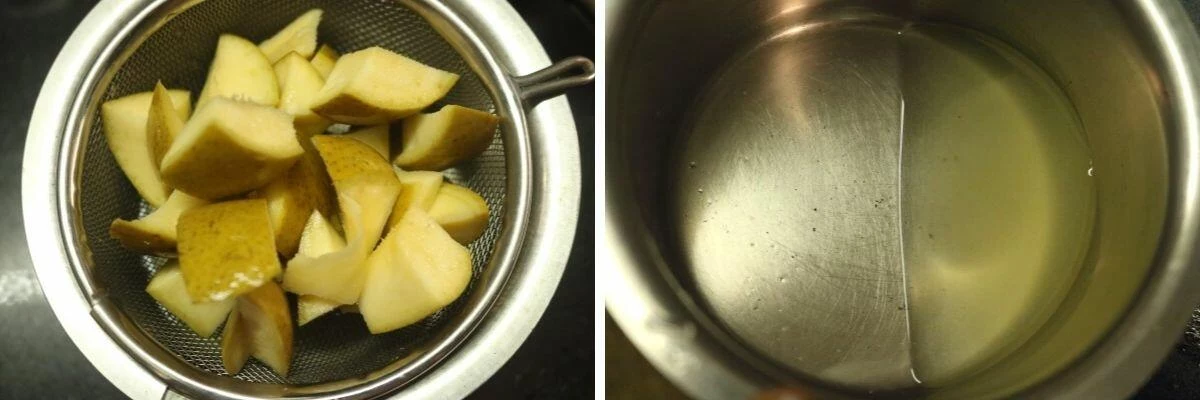
- Keep the jar aside “as is”.
- If you have 1/4 cup of juice, add 3/4 cup of water to it. Add 3 times as much water as the juice you get.
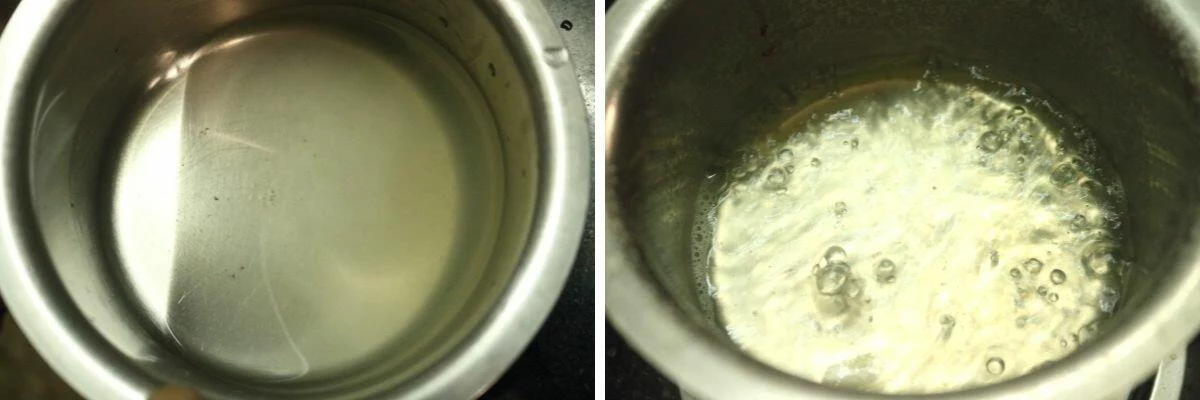
- Over low heat simmer, the salted mango juice + water mix till it reduces to half.
- Let the reduced water cool completely to room temperature.
- Grind the cooled mustard and chillies together to a coarse powder.
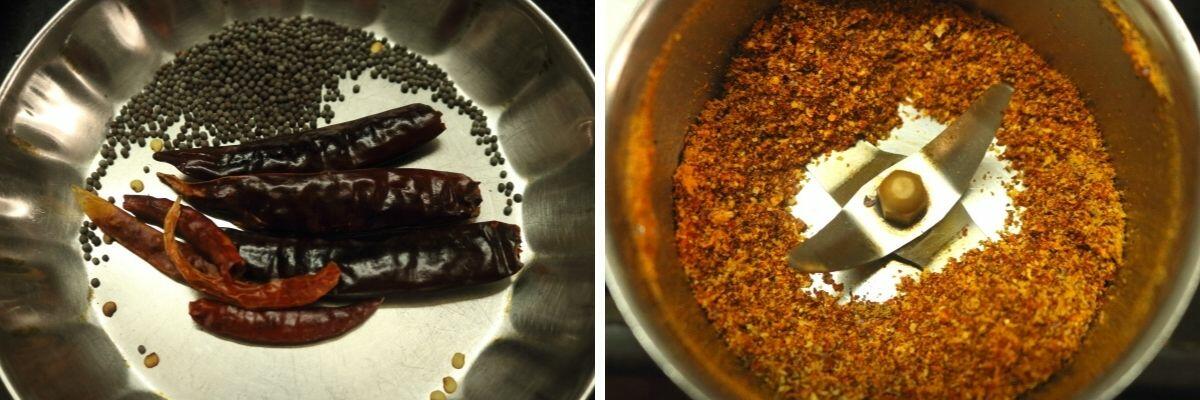
- Add 1/2 the cooled water and grind to a coarse paste.
- Add the remaining water and pulse a couple of times so that the spices mix well with the water.
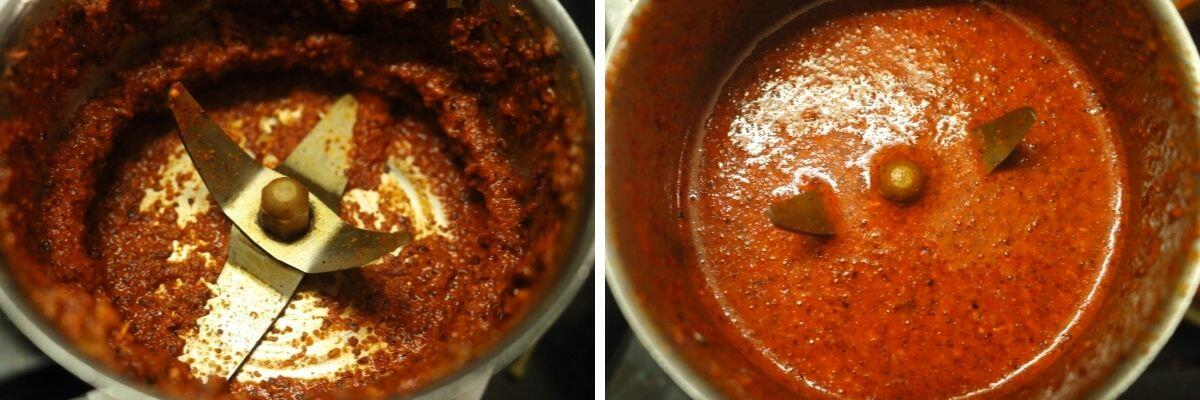
- Add the mango pieces back to the jar in which they were salted.
- Pour the spice mix into the jar.
- Seal the jar and gently shake it so that the mango pieces are covered in the masala.

- Set aside for 3-4 days before using the Mavinakayi Uppinakayi.
- Some tips for using and storing Mavinakayi Uppinakayi
- After the Mavinakayi Uppinakayi has pickled, transfer as much as you need to a smaller jar and use.
- If you handle this pickle carefully, it will last for a few months.
- When in doubt, refrigerate the pickle and then it will preserve well for over an year.
- Serving Ideas
- Serve the Mavinakayi Uppinakayi as a side to curd rice or dal rice.

Recipe for Mavinakayi Uppinakayi
Mavinakayi Uppinakayi | No-Oil, Water-based Mango Pickle
Equipment
- 1 Air-tight Glass or Ceramic Jar – 400 gms Capacity
- 1 dry spoon
- 1 Steel Vessel – 200 ml capacity
- Grinder
- Plate
- Small Wok
Ingredients
- 1 Large Raw Mango (300 gms)
- 1 tsp Mustard Seeds (3 gms)
- 8 Red Chillies; ideally 4 Bydagi Chillies and 4 Guntur/Pandi Chillies (5 gms)
- 3 tsp Salt (15 gms)
- 3/4 Cup Water
Instructions
- Ensure you have a dry air-tight glass or ceramic jar of at least 400 ml capacity on hand.
- Ensure that the mango is dry. If required wipe with a dry cotton cloth and then air-dry it for 15 to 20 minutes.
- Cut a large unripe mango (mine was about 300 gms) into 1″ pieces. After discarding the seeds, my pieces weighed 250 gms. This was 1.25 cups of pieces.
- Divide the mango pieces into 3 portions.
- Add one portion to the jar and add 1 tsp of salt on top of it.
- Now add another portion of mango pieces and add 1 tsp of salt.
- Finally add the third portion of mango pieces and 1 tsp of salt.
- Close the jar and shake a few times using a gentle motion so that the mango pieces and salt mix well.
- Set aside in a cool dark place for 3 days.
- Gently shake the bottle every day so that the mango pieces get covered in the juice that seeps out of the mango pieces.
- Dry roast 1 tsp of mustard seeds for a few seconds; just enough the warm them.
- Transfer to a plate to cool.
- Dry roast 8 dried red chillies for a few seconds; once again, just to warm them.
- Transfer to the plate to cool completely to room temperature.
- Ensure you have a large, dry soup strainer and a dry stainless steel vessel on hand.
- On day 3 after salting the mango pieces, using a dry soup strainer or colander, drain the juice from the mango pieces into a steel vessel. I got 1/4 cup of juice.
- Keep the jar aside “as is”.
- If you have 1/4 cup of juice, add 3/4 cup of water to it. Add 3 times as much water as the juice you get.
- Over low heat simmer, the salted mango juice + water mix till it reduces to half.
- Let the reduced water cool completely to room temperature.
- Grind the cooled mustard and chillies together to a coarse powder.
- Add 1/2 the cooled water and grind to a coarse paste.
- Add the remaining water and pulse a couple of times so that the spices mix well with the water.
- Add the mango pieces back to the jar in which they were salted.
- Pour the spice mix into the jar.
- Seal the jar and gently shake it so that the mango pieces are covered in the masala.
- Set aside for 3-4 days before using the Mavinakayi Uppinakayi.
- Serve the Mavinakayi Uppinakayi as a side to curd rice or dal rice.
Notes
- After the Mavinakayi Uppinakayi has pickled, transfer as much as you need to a smaller jar and use.
- If you handle this pickle carefully, it will last for a few months.
- When in doubt, refrigerate the pickle and then it will preserve well for over an year.
Serving Ideas



Leave a Reply